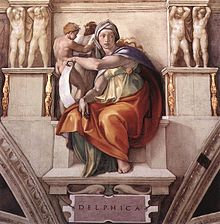|
Greek city of
Gergis in
Troas
Bronze 17mm (3.85 grams) Struck circa 400-300 B.C.
Reference: Sear 4099; SNG München 199
Facing laureate head of
Sibyl
Herophile, head turned slightly right and wearing necklace.
ΓEP before
Sphinx
seated right.
The Sibyl played an important role in antiquity. The first recorded use of the
name Sibyl was in the fifth century BC. Originally Sibyl was the name given to a
single prophetic woman. However the name became generic, and Sibyl was used to
identify a woman who could prophesize. The Sibyls were most commonly associated
with Apollo, who provided them with divine insight into the future. They were
highly revered, and there work was accumulated in a corpus called the Sibyline
books. This collection was housed in the Capitoline Temple of Jupiter., where
they could only be consulted by the senate. The interest in sibyls throughout
the Mediterranean world most likely stemmed from their close connection with
Rome and the Sibyline corpus. The Sibyl Herophile was one of the ten Sibyls
commonly known. She was a daughter of a nymph and a mortal. Herophile was meant
to have been born near Gergis, at Marpessus, and her tomb was in the temple of
Apollo at Gergis. Gergis was one of the three cities known to commemorate Sibyls
on their coins. Her appearance on coins from Gergis would be a way of paying
tribute to Herophile as well as indicating the important location of Gergis in
terms of its proximity to the resting place of divine Sibyl. Herophile was said to have predicted the
fall of Troy. She gave her prophecies in verse, and she delivered them
standing on a stone which she always carried with her.
You are bidding on the exact item pictured,
provided with a Certificate of Authenticity and Lifetime Guarantee of
Authenticity.
The sibyls were
women that the
ancient Greeks
believed were
oracles
. The earliest sibyls, according to
legend, prophesied
at holy sites. Their prophecies were
influenced by
divine inspiration
from a deity; originally at
Delphi
and
Pessinos
, the deities were
chthonic
deities. In later antiquity, various
writers attested to the existence of sibyls in Greece,
Italy
, the
Levant
, and
Asia Minor
.
The English word sibyl (
or
/ˈsɪbɪl/) comes — via the
Old French
sibile and the
Latin
sibylla — from the
ancient Greek
σίβυλλα
(sibulla, plural σίβυλλαι
sibullai).
Varro
derived the name from
theobule
(“divine counsel”), but modern
philologists mostly propose an
Old Italic
or alternatively a
Semitic
etymology.

Michelangelo
‘s Delphic Sibyl,
Sistine Chapel
The word sibyl probably comes (via
Latin
) from the
Greek
word sibylla, meaning
prophetess
.
The earliest oracular seeresses known as the sibyls of antiquity, “who
admittedly are known only through legend”
prophesied at certain holy sites, under the divine influence of a deity,
originally— at Delphi
and
Pessinos
— one of the
chthonic
earth-goddesses. Later in antiquity, sibyls wandered from place to place.
The oldest collection of written Sibylline Books appears to have been made
about the time of Solon
and Cyrus at
Gergis
on Mount Ida
in the Troad
. The sibyl, who was born near there, at
Marpessus
, and whose tomb was later marked by the temple of Apollo built
upon the archaic site, appears on the coins of Gergis, ca 400–350 BCE.
(cf. Phlegon, quoted in the 5th century geographical dictionary of
Stephanus of Byzantium
, under ‘Gergis’). Other places claimed to have been
her home. The sibylline collection at Gergis was attributed to the
Hellespontine Sibyl
and was preserved in the temple of Apollo at Gergis.
Thence it passed to
Erythrae
,
where it became famous. It was this very collection, it would appear, which
found its way to Cumae
and from Cumae to Rome. Gergis, a city of
Dardania
in the Troad, a settlement of the ancient
Teucri
, and,
consequently, a town of very great antiquity (Herodotus iv: 122). Gergis,
according to Xenophon
, was a place of much strength. It had a temple sacred to
Apollo Gergithius
, and was said to have given birth to the Sibyl, who is
sometimes called
Erythraea
, from Erythrae, a small place on
Mount Ida
(Dionysius
of Halicarnassus i. 55), and at others Gergithia (‘of Gergis’).

A
sphinx is a
mythical creature
with, as a minimum, the body of a
lion and the head of a human or a cat.
In Greek tradition, it has the haunches of a lion, the wings of a great bird,
and the face of a woman. She is mythicised as treacherous and merciless. Those
who cannot answer her riddle suffer a fate typical in such mythological stories,
as they are killed and eaten by this ravenous monster.
Unlike the Greek sphinx which was a woman, the Egyptian sphinx is typically
shown as a man (an androsphinx). In addition, the Egyptian sphinx was
viewed as benevolent in contrast to the malevolent Greek version and was thought
of as a guardian often flanking the entrances to temples.
In
European decorative art, the sphinx enjoyed a major revival during the
Renaissance
. Later, the sphinx image, something
very similar to the original Ancient Egyptian concept, was exported into many
other cultures, albeit often interpreted quite differently due to translations
of descriptions of the originals and the evolution of the concept in relation to
other cultural traditions.
Generally the role of sphinxes is associated with architectural structures
such as royal tombs or religious temples. The oldest known sphinx was found near
Gobekli Tepe
at another site, Nevali Çori,
or possibly 120 miles to the east at Kortik Tepe,
Turkey
and was dated to 9,500 BC.
|










